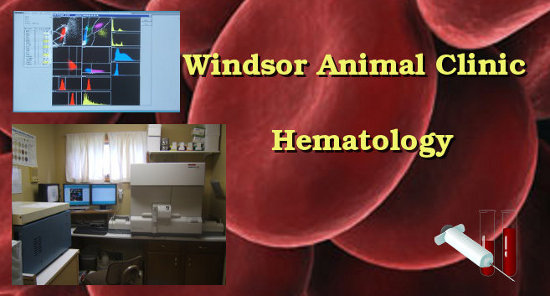
Hematology – The branch of medicine that deals with the blood and blood-producing organs. Windsor Animal Clinic is lucky to have one of the most advanced 5 part differential laser machines. (Test is nick named “CBC”)
(pdf brochure diagnostic testing) courtesy of IDEXX.
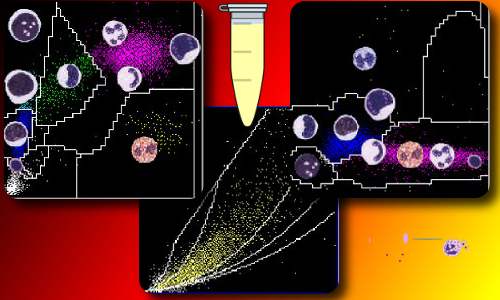
The following are some parameters we can measure: (Why run this test ?)
 Red Blood Cells (RBC) – Responsible for carrying oxygen and carbon dioxide throughout the body. High red blood cell numbers usually indicate dehydration but can also indicate uncommon diseases that cause an excess production of red blood cells from the bone marrow. Iron deficiency will lower RBC count. In more reduced count, it may indicate hemorrhage, parasites, bone marrow disease, B-12 deficiency, folic acid deficiency or copper deficiency some immune diseases and toxin ingestion. RBC’s live for 120 days so an anemia of any kind other than hemorrhage indicates a long standing problem.
Red Blood Cells (RBC) – Responsible for carrying oxygen and carbon dioxide throughout the body. High red blood cell numbers usually indicate dehydration but can also indicate uncommon diseases that cause an excess production of red blood cells from the bone marrow. Iron deficiency will lower RBC count. In more reduced count, it may indicate hemorrhage, parasites, bone marrow disease, B-12 deficiency, folic acid deficiency or copper deficiency some immune diseases and toxin ingestion. RBC’s live for 120 days so an anemia of any kind other than hemorrhage indicates a long standing problem.
Hematocrit (HCT) or Packed Cell Volume (PCV)– Provides information on the amount of red blood cells (RBC’s) present in the blood. The hematocrit is a calculated percentage of red blood cells in the circulation. It gives similar information to the red blood cell count but the value is expressed as a percentage. The other part of the blood is serum, containing enzymes, proteins, electrolytes, etc. Decreased levels means anemia from hemorrhage, parasites, nutritional deficiencies or chronic disease process, such as liver disease, cancer, etc. . Increased levels are often seen in dehydration.
Mean Corpuscular Volume (MCV) – This is the average size of the red blood cells. A high MCV usually indicated certain vitamin deficiencies. A low MCV indicated iron deficiency.
Mean Corpuscular Hemoglobin (MCH) – is an abbreviation for mean corpuscular hemoglobin. This is the average weight of hemoglobin in each red blood cell and is different than hemoglobin circulating in the blood. A high MCH indicates poorly oxygenated blood. A low MCH indicates iron deficiency.
Mean Corpuscular hemoglobin Concentration (MCHC) – is an abbreviation for mean corpuscular hemoglobin concentration. This is the average percentage of hemoglobin in each red blood cell. A high MCHC indicates that there is too much hemoglobin in the red blood cell, indicating a high iron level since an important component of hemoglobin is iron. Iron excess is just as damaging to the body as iron deficiency. A low MCHC indicates anemia.
Reticulocytes – Immature red blood cells. Decreased count is usually associated with anemia. Increased count is associated with chronic hemorrhage or hemolytic anemia.
Platelets (PLT) – Play an important role in blood clotting. Decrease in number occurs in bone marrow depression, autoimmune hemolytic anemia, systemic lupus, severe hemorrhage or intravascular coagulation. Increased number may occurs with fracture or blood vessel injury, or cancer
White blood cells (WBC) – Elevated white blood cell counts indicate infection, inflammation and some forms of cancer or leukemia. Low white blood cells counts can indicate viral infections, bone marrow abnormalities or overwhelming infections and sepsis (blood poisoning). In this situation, the white blood cells are concentrated in the area of infection and are not circulating in the blood, resulting in a low count.
The Differential
A differential is an analysis of the different types of white blood cells. There are five types of white blood cells and the distribution of these cells can help determine an underlying cause of illness.
 Segmental Neutrophils (Segs) – These are the primary white blood cells responsible for fighting infections. High levels of neutrophils indicate infection. Low levels can indicate sepsis. The neutrophils are concentrated in the area of infection or are rapidly being used, leaving less circulating in the blood.
Segmental Neutrophils (Segs) – These are the primary white blood cells responsible for fighting infections. High levels of neutrophils indicate infection. Low levels can indicate sepsis. The neutrophils are concentrated in the area of infection or are rapidly being used, leaving less circulating in the blood.
 Lymphocytes (L/M) – These smooth, round white blood cells are responsible for fighting infection and also develop antibodies to protect the body against future attacks. High levels of lymphocytes can indicate infection, viral disease or certain cancers such as lymphosarcoma. Low levels can indicate viral infections affecting the bone marrow or sepsis.
Lymphocytes (L/M) – These smooth, round white blood cells are responsible for fighting infection and also develop antibodies to protect the body against future attacks. High levels of lymphocytes can indicate infection, viral disease or certain cancers such as lymphosarcoma. Low levels can indicate viral infections affecting the bone marrow or sepsis.
 Monocytes (Mono) – This white blood cell helps the neutrophils fight infections. High monocyte counts indicate infection. It is unlikely that there will be no monocytes and a differential with zero monocytes does not indicate any specific ailment.
Monocytes (Mono) – This white blood cell helps the neutrophils fight infections. High monocyte counts indicate infection. It is unlikely that there will be no monocytes and a differential with zero monocytes does not indicate any specific ailment.
 Eosinophil (Eos) – This white blood cell is primarily involved in fighting allergies or parasites. High eosinophil counts indicate an allergy or parasite causing illness. Low levels are not possible since zero eosinophils are possible in normal blood samples.
Eosinophil (Eos) – This white blood cell is primarily involved in fighting allergies or parasites. High eosinophil counts indicate an allergy or parasite causing illness. Low levels are not possible since zero eosinophils are possible in normal blood samples.
 Basophils (Baso) – This white blood cell is not very common but can be seen in certain parasitic infection, primarily heartworm. High levels indicate possible parasitism. Low levels are not possible since zero basophils are possible in normal blood samples.
Basophils (Baso) – This white blood cell is not very common but can be seen in certain parasitic infection, primarily heartworm. High levels indicate possible parasitism. Low levels are not possible since zero basophils are possible in normal blood samples.
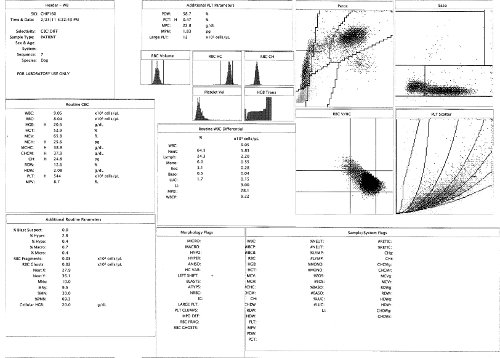
Advanced scattergrams to help interpret the cbc information mentioned above.
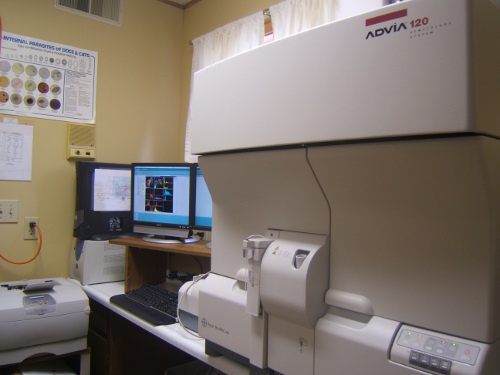
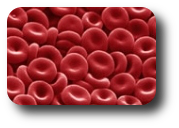
![]()

